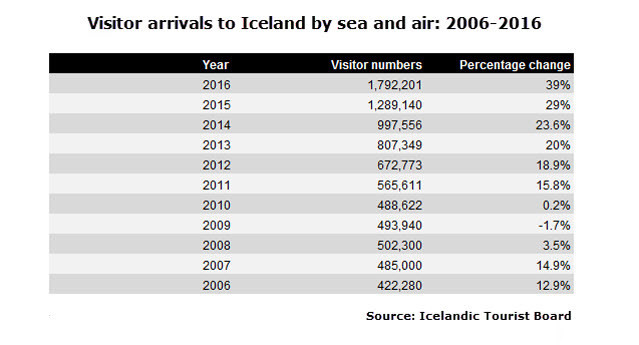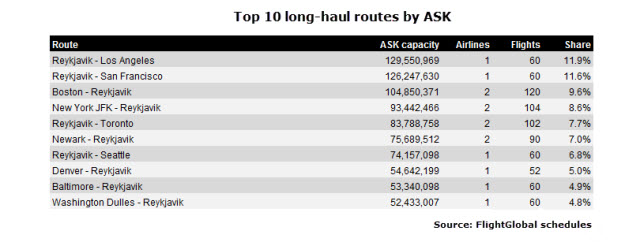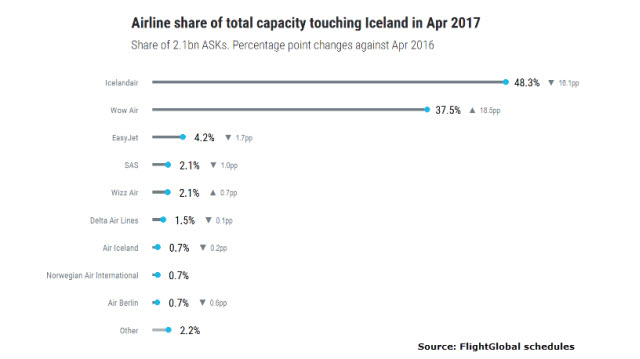To gauge something of the extraordinary increase in air traffic to Iceland in recent years, you need look no further than the growth in the Icelandair fleet, chief executive Birkir Holm Gudnason suggests.
The airline celebrates its 80th anniversary this year. Gudnason notes that for the first 75 of those years the Icelandair fleet numbered no more than 12 aircraft; today, it is up to 30.
"If you talk about the last four or five years, there has been a boom in the tourism to Iceland. You have seen 20-40% increase in the number of tourists coming to Iceland," he says.
Figures from the Icelandic tourist board illustrate the point. From a mid-financial-crisis low point in 2009, when visitor numbers fell 1.7%, Iceland's tourism market has rebounded, consistently achieving double-digit annual growth since 2010.

Gudnason attributes much of this growth to the new capacity that has been added to the Icelandic market in recent years.
Driving much of this are Icelandair and Wow with competing hub operations drawing transatlantic traffic through Reykjavik's Keflavik airport; but there is also an increasing number of network and low-cost carriers that have added their own services to the Nordic country.
Five years ago, Gudnason estimates that six airlines were operating to Reykjavik, compared with 26 today. He sees airlines such as EasyJet connecting Iceland to previously untapped markets.
FlightGlobal schedules data shows that Icelandair is the largest carrier, accounting 48.3% of ASKs, followed by Wow with 37.5%. EasyJet is a distant third with 4.2%.
TRANSATLANTIC TUSSLE
Since 2009, Icelandair's network has been focused on serving the transatlantic market.
Gudnason says this strategy suits Icelandair for a number of reasons. With a total Icelandic population of just 320,000, the carrier can only hope to increase its indigenous traffic by 5-10% per annum – but transatlantic transit traffic offers almost unlimited potential.
He points out that 50% of all transatlantic travellers fly to their destination via a stop. Only 37% of passengers travel direct, he says.
"So there is a big market for connecting if you do it in Iceland, or London, or Frankfurt, and that is the strategy we put forward," Gudnason says.
He describes the strategic benefits of Iceland's location for transatlantic flighs as being "very similar" to that of Helsinki for Finnair's Asian network. From Reykjavik, Icelandair can operate to both Europe and North America using narrowbodies.
Flight Fleets Analyzer shows that the airline has a fleet of 32 aircraft, comprising 27 757-200s, one 757-300 and four 767-300ERs.

"Most of the airlines flying from Europe to North America fly over Iceland, and we have been looking at markets to grow in North America, where we have a comparative advantage in travelling time – [where it is] easier to connect through Iceland than maybe Heathrow or Frankfurt. So, we have been looking for traffic between North America and Europe where Iceland has a convenient connection, and that has been successful," Gudnason says.
He describes Icelandair's route development strategy as one of seeking out "so-called secondary markets" where the carrier can gain a comparative advantage in transit processing time compared with congested hubs such as London Heathrow and Frankfurt.
But Icelandair doesn't have the market all to itself.
Wow began operations in 2012, first by serving European short-haul destinations from Reykjavik. But following its acquisition of Iceland Express in 2013, it began branching out into transatlantic markets using Airbus A321 jets.
Today, Icelandair and Wow compete on a number of services. On transatlantic routes from Reykjavik, both carriers operate services to New York, Boston and Toronto, for example. In July, Wow will add a new service to Chicago, a route Icelandair also already operates.
"They [Wow] have created their own hub-and-spoke route network like we have," Gudnason says. "50% of our traffic is transit traffic, so we have actually been in a huge competition for decades with the big airlines on the transatlantic [market] – so that is just normal for us."
Gudnason likens the competitive landscape in Iceland to that of the Middle East, where several hub carriers compete for transfer passengers, with the result that "there is a lot of traffic going through the Middle East instead of Europe today".
The competition between Icelandair and Wow is set to intensify as both take delivery of new aircraft. Wow will receive seven new jets from the middle of this year, comprising four Airbus A330-900s and three A321s, giving the carrier a fleet of 17 jets.
Icelandair will receive the first of 16 Boeing 737 Max jets in 2018.
Gudnason says the carrier is yet to decide on the destinations for its Max jets, saying: "It has a lot of flexibility because you can go into secondary markets we are not flying into today.
"You can build up frequencies to current gateways, you can fly all year into some of the summer gateways… and you can build up new markets with the Max and put in bigger aircraft once you build it up," he adds.

YIELD PRESSURES
Gudnason concedes that yields on the transatlantic market have dropped over the past three to six months.
He says capacity on the transatlantic market had been increasing 3% to 6% annually – and was then boosted 8% in 2016. Low-cost carrier Norwegian contributed 40-50% of the growth added last year, he says.
Gudnason attributes the drop in yields to a combination of competition from low-cost carriers and the realignment of ticket prices to reflect the relatively low price of oil.
"I don't believe it is the competition only," he says. "I think it is also that the fuel prices have gone down in 2015 and 2016, and the fares are just getting closer to the level of the fuel costs. I think [20]15 was a unique year in the airline industry because most of the airlines had sold the tickets when the fuel went down a lot, so a lot of airlines gained from that.
"But then [20]16 and now this winter, the fares are going more closely to the fuel cost, so I think that is also a reason for the yields going down. It's a huge market and probably the low-cost share of the market is around 10% – 80%-85% of the market is the three [airline] alliances," he adds.
Gudnason also says changes in demand have played a role in reducing yields, but adds that these are more difficult to "put a finger on". He cites overcapacity and the negative impact of the election of US president Donald Trump as possible factors.
EUROPEAN MOMENTUM
The boom in tourism has also increased interest from the rest of Europe in serving Iceland, particularly Reykjavik. FlightGlobal schedules data for April 2017 shows flight and seat capacity into Iceland on European routes up more than a fifth compared to the same month last year - and by a third as measured by ASKs.

Wow Air has added new services to Edinburgh, Frankfurt and Stockholm in the last 12 months, and will next month begin flights to Cork in Ireland. Icelandair meanwhile has added flights to Hamburg and raised capacity into several other European airports, notably Paris Orly.
Between them the two Icelandic operators account for almost two-thirds of European capacity from Iceland.
But alongside expansion in the European market by local carriers, there has been notable increased interest in Iceland - and Reykjavik in particular, from other European operators. Low-cost carriers EasyJet, Norwegian, Vueling and Wizz.
EasyJet bolstered connections from UK airports, notably Manchester and London Gatwick. Wizz has added new flights from Katowice, Vilnius and Warsaw, Norwegian has added a Barcelona service - a route on which Vueling has increased capacity by a third.
Wizz also plans to open Reykjavik flights from the Czech capital Prague and Polish city Wroclaw in May. Czech Airlines plans its own service from Prague to Reykjavik from June.
Finnair meanwhile launched services from Helsinki this summer, while British and SAS were among European network carriers to boost Icelandic capacity.
CAPACITY SQUEEZE
But the boost in Icelandic tourism has put pressure on the country's hotel and airport infrastructure.
While there are numerous airports dotted around the island, including at Akureyri and Egilsstadir, international traffic is concentrated at Keflavik.
In March, the chairman of Icelandic travel industry association SAF floated the suggestion that seasonal traffic could be diverted to airports other than Keflavik in order to reduce pressure on the gateway at peak summer times.
Wow's transatlantic ambitions were temporarily delayed in 2013 because the budget carrier could not secure the necessary slots. In November 2015, chief executive Skuli Mogensen revealed in an interview with FlightGlobal that he was looking for a base outside of Iceland because of concerns over congestion at Keflavik.
Passenger numbers rose more than 40% to 6.8 million in 2016, figures released by Keflavik airport operator Isavia show.
Isavia forecasts that passenger numbers will grow 28% in 2017, to 8.75 million. For the first time, a majority of the airport's passengers this year will be transiting.
Keflavik is in the midst of an expansion programme as part of its 2015-2040 masterplan. This envisages extending the existing terminal, adding two new piers and building a new runway in a staged process so that the airport can handle up to 14 million passengers per annum by 2040.
While Isavia says on its website that construction work is staggered "with each stage accommodating forecast passenger numbers and stand demand", Icelandair's Gudnason suggests that the masterplan is "a little behind", adding: "I think in that growth has been much faster than people expected."
Gudnason concedes that there are issues around "slot constraints" at Keflavik airport, but believes that avoiding peaks times offers ways around this.
"You have periods in the airport from 09.00 to 14.00 which are empty almost, very little used, and from 18.00 to 23.00," he says. "So there are ways to grow in the future; it's just a question of how you do it."
Gudnason says Icelandair has sought to add frequencies during these quieter times and has also increased capacity in the winter months to reduce seasonality at the gateway.
The airline is also utilising Reykjavik's city airport for domestic flights operated by its subsidiary Air Iceland. The regional carrier deploys Bombardier Q400s to destinations such as Isafjordur and Akureyri and on routes to Greenland.
Air Iceland is also now branching out into European markets. The airline operates from Keflavik to Aberdeen and will add a link to Belfast in June.
Gudnason says that while the potential for Air Iceland to expand greatly in international markets is limited, it might help to open new thin routes that could be taken over by Icelandair's Max jets at a later date.
EMERGING RISKS
While the phenomenal growth in tourism has helped Iceland to mitigate the worst effects of the 2008 financial crisis, its very success creates a potential risk factor.
In a financial stability report released earlier this month, the Central Bank of Iceland identified the tourism sector as one of the principal risks in the financial system, with others being the real-estate market and a "changed landscape" following the removal in March of the last of the country's capital controls.
The report says that tourism is now the third-largest investment class in banks' loan portfolios, after real-estate companies and fisheries – and the ever-increasing demand for new accommodation is putting pressure on the Iceland's real-estate market.
Icelandair's Gudnason does not go as far as to identify the growth of tourism as a risk. However, he does note that the annual rate of growth in tourist arrivals into Iceland, which has ranged between 20% and 40% per annum over the last half-decade, is more than twice the rate that Icelandair calculates is "sustainable", which he puts in the 8-12% bracket.
The nation's strengthening currency could contribute to a slowing in the growth of its tourist numbers in the coming years, he adds.
Gudnason says that he has not seen any evidence yet that the "boom" in arrivals in recent years is slowing, but the rising value of the krona is "making things more expensive".
He adds: "We don't see this year that it is affecting the demand, but the currency could affect it."
On a positive note, Iceland has adopted capital flow management measures designed to prevent any repeat of the 2008 banking meltdown.
Barring another volcanic eruption on the scale of Eyjafjallajokull – which temporarily shut down European air traffic in 2010 – the prospects for Icelandic tourism, and by extension its air traffic markets, seem bright.
Source: Cirium Dashboard



















